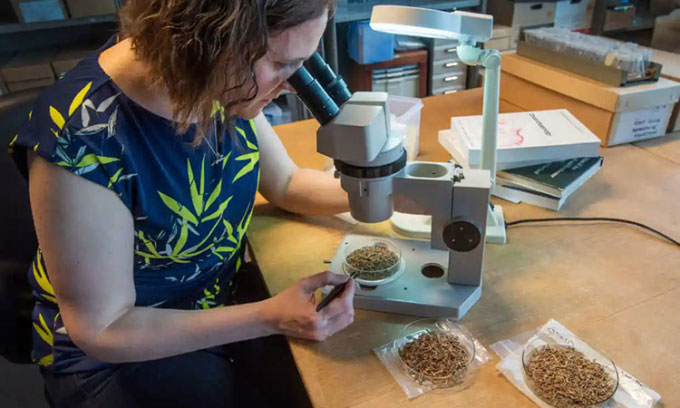The discovery of a massive number of frog bones in a 14-meter-long ditch next to a settlement dating back approximately 2,000 years has left scientists puzzled.
Archaeologists were astonished to find over 8,000 frog bones in a 14-meter-long ditch beside an ancient roundhouse at Bar Hill, northwest of Cambridge, where a settlement existed during the Iron Age (from 400 BC to 43 AD).

Animal archaeologist Vicki Ewens analyzes the frog bones found at Bar Hill. (Photo: MOLA/Andy Chopping)
The new discovery was made during an excavation by the Museum of London Archaeology (MOLA) and Headland Archaeology as part of the upgrade plans for the A14 road from Cambridge to Huntingdon, reported the Guardian on June 12.
While finding frog bones at archaeological sites is not unusual, the sheer volume of bones at Bar Hill has left scientists bewildered. “Having so many bones in a single ditch is extremely unusual,” said Dr. Vicki Ewens, a senior animal archaeologist at MOLA. She also noted that the majority of these bones belong to common frogs and toads, species that are present in garden ponds across England.
Many ancient civilizations, such as those in Egypt, Mesopotamia, Greece, and Rome, regarded frogs as symbols of fertility and other meanings. However, the frog bones at Bar Hill are prehistoric, making it challenging to determine their exact significance.
It is unlikely that these animals died because the residents of the Bar Hill settlement consumed them. Archaeologists noted that while there is evidence of amphibian consumption in England dating back to the Stone Age, these bones show no signs of cuts or burn marks. However, if the frogs were boiled, they might not leave traces.
Charcoal grains near the settlement indicate that the inhabitants consumed plants that attract pests like beetles and aphids, which are a food source for frogs. Thus, it is possible that frogs were drawn to the area due to the abundant food supply.
Another explanation is the notion of a “prehistoric frog tragedy.” According to experts, frogs migrate in large numbers during spring to find breeding waters. They may have fallen into the ditch and become trapped.
A third hypothesis suggests that frogs died unusually due to harsh winter conditions. Frogs hibernate and sometimes hide in mud, but extremely cold weather can kill them. Additionally, they may have fallen ill, similar to the 1980s when frogs in England were heavily affected by ranavirus.
Experts are still uncertain about the depth of the ditch and have only excavated about one meter of soil. They also found a small amount of household waste in the area, including Iron Age pottery shards.
This discovery is one of many archaeological finds made during approximately 40 excavations conducted from 2016 to 2018 over an area of 234 hectares, which included artifacts and human remains. Although the excavations have concluded, experts continue to analyze the findings.
Ewens has been studying the excavated animal bones for the past two years. By synthesizing all the research, scientists hope to gain further insights into life thousands of years ago and uncover the reasons behind the mass deaths of these amphibians.
















































